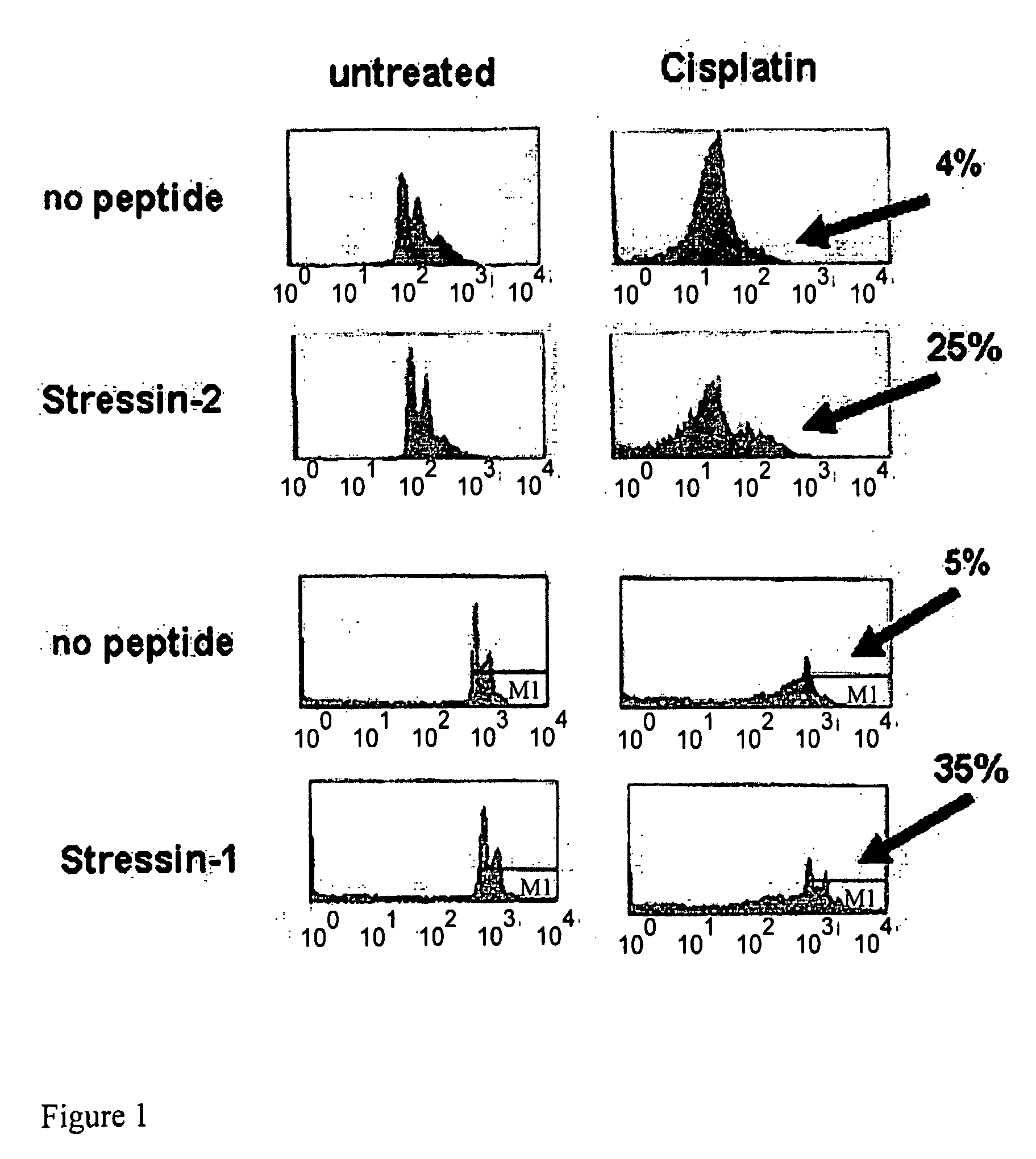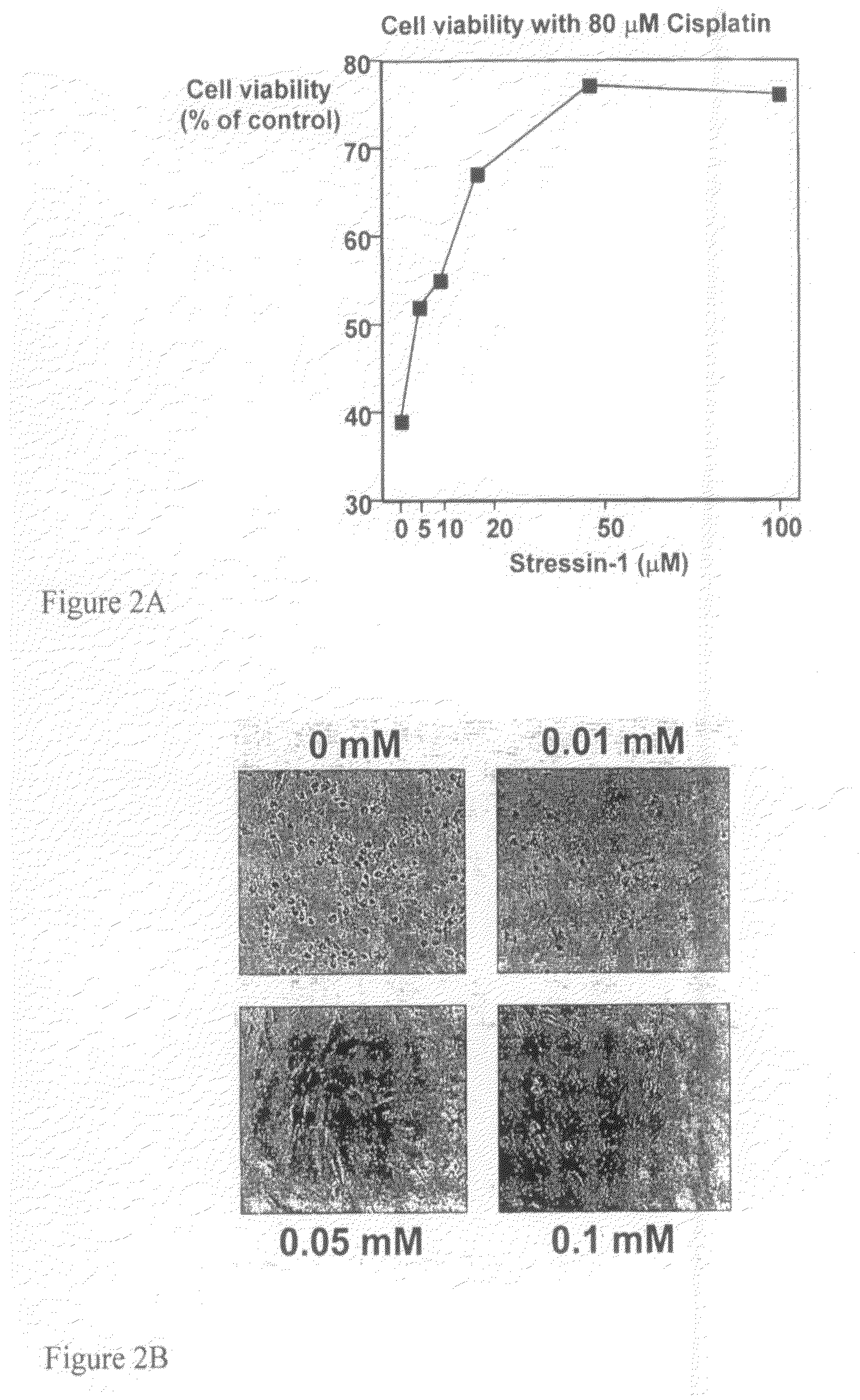Peptide Inhibitors for Mediating Stress Responses
a technology of peptide inhibitors and stress responses, applied in the field of peptides recognized, can solve the problems of limiting the effectiveness of these therapies, affecting the survival of cells, and affecting the survival rate of cells, and achieve the effect of increasing cell survival
- Summary
- Abstract
- Description
- Claims
- Application Information
AI Technical Summary
Benefits of technology
Problems solved by technology
Method used
Image
Examples
example 1
Peptide Selection from Phage Display Libraries
[0182]The monoclonal anti-PAb-421 antibodies Idi-1 and Idi-2 were generated and characterized as described (Herkel et al., 2004). Briefly, BALB / c mice were immunized three times with PAb-421 and the spleen cells of the mouse that produced the highest anti-PAb-421 titers were fused with NSO myeloma cells. Supernatants of the growing cells were screened by ELISA for binding to PAb-421 and to DNA. The hybridomas Idi-1 and Idi-2 were isolated and cloned twice by limiting dilution.
[0183]Ph.D.-7 or Ph.D.-12 libraries from New England Biolabs, Frankfurt, Germany were screened according to manufacturers instructions. Briefly, three rounds of selection by Idi-1 or Idi-2 monoclonal antibodies were performed and consensus peptide sequences were identified by sequencing of phage DNA. Candidate peptides were then synthesized by Sigma-Genosis (Pampisford, UK) and further studied in functional assays, as described hereinbelow.
example 2
Examining the Effect of Candidate Peptides on p53-Mediated Growth Arrest
[0184]The selected candidate peptides were tested for their ability to interfere with the p53-mediated cellular stress response by testing their capacity to inhibit the response to hyperthermia of the L12 cell line (Wolf, 1984), which lacks endogenous p53 activity and had been stably transfected with the p53 gene or a control vector. In these cells, p53 activity induces growth arrest and cell survival rather than apoptosis in response to hyperthermia (Nitta, 1997).
[0185]The amount of cell death was assessed by staining the cells with the vital dye trypan blue (Sigma) and counting the ratio of dead / live cells per visual field with a light microscope.
[0186]Results: incubation for 2 hours at 42° C. induced death of all cells that lacked p53 and, in contrast, transient growth arrest and survival of about 80% of the cells with active p53. Four peptides, designated Stressin-1 to-4 (for STress RESponse Specific peptide...
example 3
Effect of Stressin Peptides on p53-Mediated Cell Death Induced by DNA Damage
[0187]L12 cells were treated for 48 hours with 50 μM of the DNA-damaging agent Cisplatin and p53-mediated cell death was determined by measuring the DNA content of cells stained with propidium iodide (FIG. 1). Cells incubated in the absence of peptide responded to Cisplatin treatment with p53-mediated cell death.
[0188]Results: FACS analysis shows that treatment with Stressin-1 or Stressin-2 rescued 35% or 25% of the cells, respectively, from p53-mediated cell death.
PUM
| Property | Measurement | Unit |
|---|---|---|
| Fraction | aaaaa | aaaaa |
| Fraction | aaaaa | aaaaa |
| Fraction | aaaaa | aaaaa |
Abstract
Description
Claims
Application Information
 Login to View More
Login to View More - R&D Engineer
- R&D Manager
- IP Professional
- Industry Leading Data Capabilities
- Powerful AI technology
- Patent DNA Extraction
Browse by: Latest US Patents, China's latest patents, Technical Efficacy Thesaurus, Application Domain, Technology Topic, Popular Technical Reports.
© 2024 PatSnap. All rights reserved.Legal|Privacy policy|Modern Slavery Act Transparency Statement|Sitemap|About US| Contact US: help@patsnap.com










